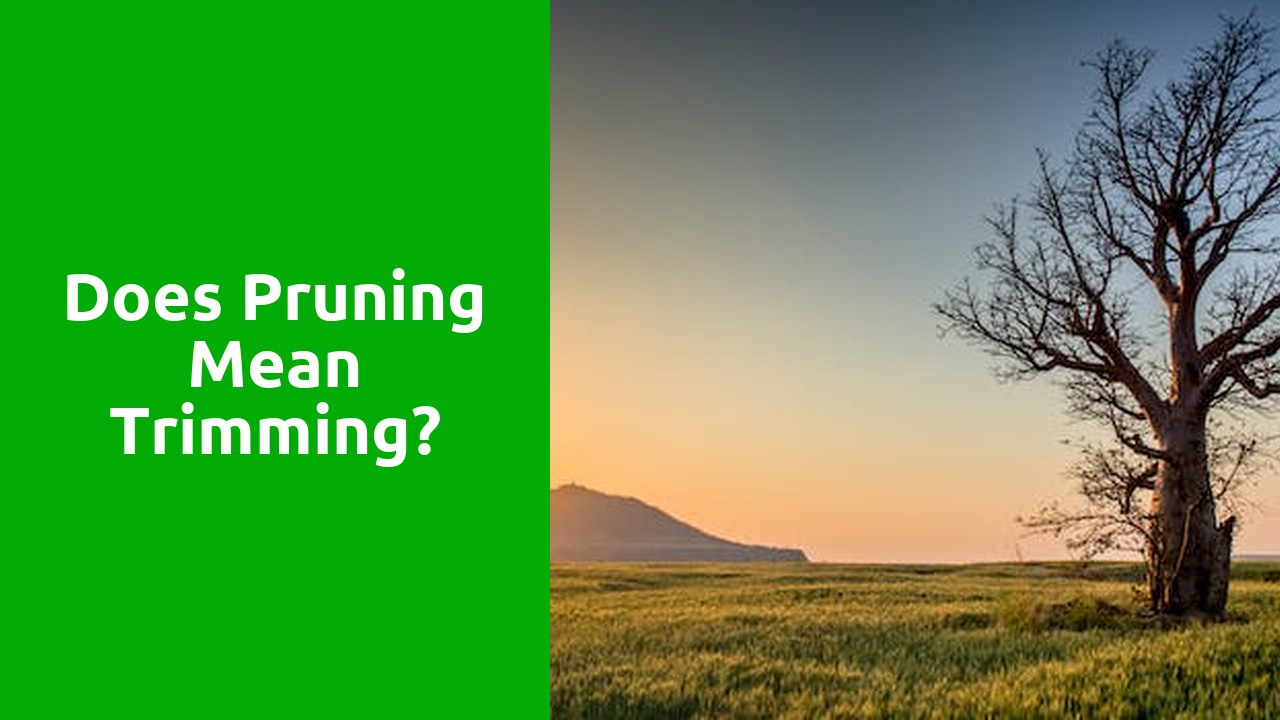Does pruning mean trimming?

What is Pruning?
Pruning is a gardening technique that involves selectively removing certain parts of a plant to promote healthier growth and improve overall appearance. It is an essential practice for maintaining the shape and size of trees, shrubs, and other plants. By cutting back dead, damaged, or overgrown branches, gardeners can enhance airflow and sunlight penetration, preventing disease and allowing for optimal photosynthesis.
When pruning, it is crucial to consider the specific needs and characteristics of each plant. Different species require varying pruning techniques and timing. For instance, some plants benefit from pruning in the dormant season, while others should be pruned immediately after flowering. Additionally, pruning tools, such as hand pruners, loppers, and pruning saws, should be utilized properly to minimize damage and ensure clean cuts. With proper pruning practices, gardeners can encourage vigorous growth, maintain plant health, and create visually appealing landscapes.
Why Pruning is Important for Plants?
Pruning is an essential practice for maintaining the health and appearance of plants. By selectively removing specific branches or stems, pruning promotes better growth, enhances flowering, and prevents diseases. One of the primary reasons why pruning is important is to remove dead or diseased parts of a plant. These can negatively impact the overall health of the plant and hinder its growth. Pruning helps to eliminate these areas, allowing the plant to direct its energy towards more productive growth.
Furthermore, pruning also helps to rejuvenate older plants and encourage new growth. As plants age, they may become leggy or overgrown, resulting in a lack of vigor and reduced flowering. By pruning back these older parts, the plant is stimulated to produce fresh shoots and foliage, revitalizing its appearance and promoting a more balanced growth. Additionally, pruning can help shape plants and maintain a desired form or size. This is particularly important for ornamental plants in gardens or landscapes, as it allows for better control over their overall aesthetic appeal.
Different Techniques for Pruning
When it comes to pruning, there are several techniques that can be used to maintain the health and aesthetics of plants. One common technique is known as "heading back" or "topping." This involves cutting back the top growth of a plant to encourage lateral branching and a more compact shape. Heading back is often used on shrubs and small trees to control their size and promote bushier growth.
Another pruning technique is called "thinning out." As the name suggests, this method involves selectively removing certain branches to improve the overall structure and air circulation of the plant. Thinning out is commonly used on trees and larger plants to reduce crowding and allow more light to penetrate through the canopy. This technique helps to prevent disease and allows for better nutrient absorption by the remaining branches.
Overall, different pruning techniques offer various benefits depending on the type of plants being pruned. It is essential to understand the specific requirements of each plant and choose the appropriate technique to ensure proper growth and vitality.
When is the Right Time to Prune?
Pruning is an essential task for maintaining the health and aesthetics of plants and trees. However, knowing when the right time to prune can be a challenge for many gardeners. The timing of pruning depends on the type of plant or tree, as well as its growth habits and flowering patterns.
For deciduous trees and shrubs, winter is often the best time to prune when they are dormant. This allows for easier visibility of the plant's structure and promotes vigorous spring growth. On the other hand, pruning flowering shrubs that bloom in spring or early summer should ideally be done after they have finished flowering. This way, you can enjoy their blossoms before shaping and tidying them up. Understanding the specific needs of your plants is crucial in determining the appropriate timing for pruning, as it can greatly impact their overall vitality and future growth.
How Pruning Promotes Healthy Growth
Pruning plays a vital role in promoting healthy growth in plants and trees. By selectively removing branches and stems, it helps to stimulate new growth, improve air circulation, and increase sunlight penetration. This process also allows the plant to allocate resources more efficiently, directing them towards stronger and more vigorous growth.
One key benefit of pruning is that it helps to maintain the overall shape and appearance of the plant. By carefully trimming and shaping the branches, it promotes a balanced structure and prevents the plant from becoming overly dense or unruly. This not only enhances the aesthetic appeal of the plant but also improves its health by ensuring that all parts receive adequate sunlight and air circulation. Additionally, pruning helps to remove dead or diseased branches, reducing the risk of infections and improving the overall health and vitality of the plant.
Common Mistakes to Avoid While Pruning
When it comes to pruning, there are a few common mistakes that many people tend to make. One of the most frequent mistakes is improper timing. Pruning at the wrong time of year can negatively affect the health and growth of the plant. It is essential to understand the specific requirements of each plant and prune them accordingly. Failure to do so can lead to stunted growth, reduced flowering, and in some cases, even death of the plant.
Another mistake that novice gardeners often make is over-pruning. It can be tempting to remove a large portion of the plant in an effort to shape it or control its size. However, excessive pruning can weaken the plant and make it more vulnerable to diseases, pests, and environmental stressors. It is important to remember that pruning should be done in moderation, allowing the plant to maintain its natural form and structure. By avoiding these common mistakes, you can ensure that your pruning efforts contribute to the overall health and beauty of your plants.
Related Links
What are 3 most common types of pruning?When should you prune?